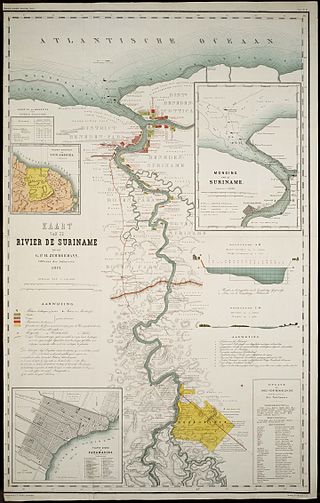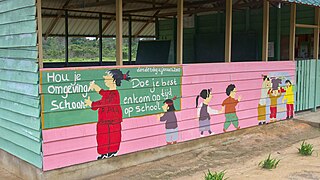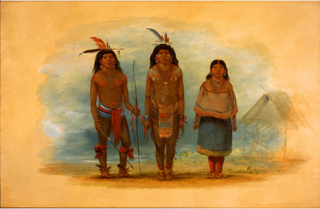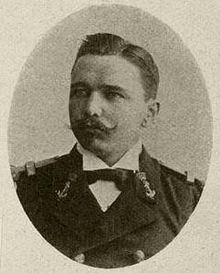
Weststellingwerf is a municipality in the province of Friesland in the northern Netherlands. It is one of the municipalities of Friesland, where the spoken language is not West Frisian; instead, Stellingwerfs, a dialect of Dutch Low Saxon, is spoken here.

The Central Suriname Nature Reserve is a conservation unit in Suriname. It preserves an area of tropical rainforest. The reserve is in pristine condition.

The Suriname River is 480 km long and flows through the country Suriname. Its sources are located in the Guiana Highlands on the border between the Wilhelmina Mountains and the Eilerts de Haan Mountains. The river flows below the reservoir along Brokopondo, Berg en Dal, the migrant communities Klaaskreek and Nieuw-Lombé, Jodensavanne, Carolina, Ornamibo and Domburg, before reaching the capital Paramaribo on the left bank and Meerzorg on the right bank. At Nieuw-Amsterdam it is joined by the Commewijne and immediately thereafter at the sandspit Braamspunt it flows into the Atlantic Ocean.
The Wilhelminagebergte is a mountain range in the district of Sipaliwini in central Suriname. It extends about 113 km (70 mi) from west to east. It is named after Queen Wilhelmina. The Wilhelminagebergte is part of the Tumucumaque Uplands of the Guiana Shield. It belongs to the very ancient (Precambrian) Guiana Highlands. Most of it is in the Central Suriname Nature Reserve.
The Eilerts de Haan Mountains are a mountain range in Sipaliwini District, Suriname. It is a southern part of Wilhelmina Mountains and is maximum 986 m high. The mountain range is part of the Central Suriname Nature Reserve.

Hendrikus Albertus Lorentz was a Dutch explorer in New Guinea and diplomat in South Africa.

Noordwolde is a village in Weststellingwerf in the province of Friesland, the Netherlands. It had a population of around 3,600 as of 2017. Noordwolde-Zuid, the settlement to the south of Noordwolde is considered a separate village.
Rudi Kappel Airstrip is located 9 kilometres (5.6 mi) south of the Tafelberg tepui in Suriname. It was constructed as part of Operation Grasshopper. It used to be named Tafelberg Airstrip, but was renamed Rudi Kappel Airstrip, after the co-pilot of a flight that crashed near Vincent Fayks Airport on 6 October 1959.
Kayser Jan Gouka Airstrip is near the Kayser Mountains range in Sipaliwini District, Suriname. It was constructed as part of Operation Grasshopper and has one long grass runway. Fishing and wildlife tours are prime users of the airstrip.

Gran Rio is a river of Suriname. The Gran Rio joins with the Pikin Rio to form Suriname River. The river runs from the northern hills of the Eilerts de Haan Mountains. It has a stony bottom, forms many tiny islands and has many rapids. At Awarradam, there are many rapids and waterfalls. The river was first explored in 1908 by Eilerts de Haan to find the source of the Suriname River.
Lucie River is a river of Suriname. It feeds into the Atlantic Ocean as well as the Courantyne River. The river was discovered and named by Eilerts de Haan in 1908. Eilerts de Haan is buried near the river.

Boven Suriname is a resort in Suriname, located in the Sipaliwini District. Its population at the 2012 census was 17,954. Almost its entire population consists of Maroons

Antonie Hendrikus Colijn was a Dutch amateur mountaineer who in 1936 led the Carstensz Expedition, being the first to climb the Carstenszgebergte in New Guinea.
The Central New Guinea Expedition (1920–1922) was a Dutch scientific expedition which was seeking from the north coast of the island to reach snow-covered Wilhelminatop of the Central Plateau of Dutch New Guinea. The expedition was organized and financed by the Indies Committee for Scientific Investigations.

Paloemeu or Palumeu is an Amerindian village in the interior of Suriname, situated at the site where the Paloemeu River joins the Tapanahoni River. Most inhabitants of the village are native Tiriyó Amerindians. The remainder belongs to the Wayana, and Aparai tribes. The Bosatlas in 1968 identified the village as Pepejoe which was incorrect according to the New West Indian Guide.

The Tigri Area is a wooded area that has been disputed by Guyana and Suriname since around 1840. It involves the area between the Upper Corentyne River, the Coeroeni River, and the Kutari River. This triangular area is known as the New River Triangle in Guyana. In 1969 the conflict ran high on, and since then it has been controlled by Guyana and claimed by Suriname. In 1971, both governments agreed that they would continue talks over the border issue and withdraw their military forces from the disputed triangle. Guyana has never held upon this agreement.

Claudius Henricus de Goeje was a Dutch Navy officer and cartographer, who took a special interest in the Wayana and Tiriyó peoples he encountered on his expeditions to the interior of Suriname. For his lifelong interest in the Amerindian peoples of the Surinamese interior, he was awarded an endowed professorship in the Linguistics and Anthropology of Suriname and Curaçao at Leiden University in 1946. De Goeje retired in 1951 and died four years later, in 1955.

Ronald "Rudi" Elwin Kappel was a Surinamese pilot. He was one of the founders of Luchtvaartbedrijf Kappel-Van Eyck which is now called Surinam Airways, the first airline in Suriname. He also helped construct the Zorg en Hoop Airport, and the Rudi Kappel Airstrip. Kappel died in an air crash near Paloemeu.

Dirk Cornelis Geijskes was a Dutch biologist, ethnologist and curator. He was the first director of the Surinaams Museum. As a biologist, he specialised in dragonflies. He would lead many expeditions into the interior of Suriname. In 1967, he became curator at the Rijksmuseum van Natuurlijke Historie where he started the dragonfly collection. Geijskes is the author of 123 publications, and 25 species have been named after him.

The Taruma are an indigenous people found in the northern Brazil, southern Guyana, and southern Suriname. They used to speak Taruma which is considered critically endangered. The Taruma in Suriname have merged with the Tiriyó, in Brazil they merged with the Wai-wai. The Wapishana village of Maruranau in Guyana still recognises the tribe.














